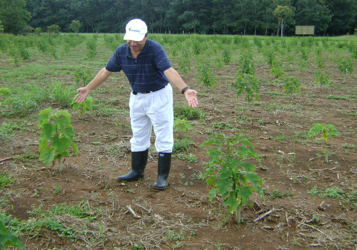Fatty acids composition of genotypes of Jatropha curcas L., in Colombia
DOI:
https://doi.org/10.15517/am.v31i1.37574Keywords:
stearic acid, linoleic acid, oleic acid, biofuelsAbstract
Introduction. Jatropha curcas L. (JC) is a specie with the potential to use its oil as a biofuel and its quality is recognized by the composition of the fatty acids present. Objective. The objective of this work was the identification and quantification of fatty acids of JC genotypes of the Jatropha Colombia Collection. Materials and methods. During the years 2012-2014 the experiment was conducted in Espinal-Tolima, Colombia, in a randomized complete block design with fifteen genotypes. The lipid profile of the genotypes was determined by chromatography GC-MS and GC-FID. Results. Ten types of fatty acids were detected in the oil: five saturated (myristic, palmitic, margaric, stearic, arachidic); three monounsaturated (palmitoleic, oleic and eicosenoic), and two polyunsaturated (linoleic and linolenic). The proportion was higher in monounsaturated acids (45.44 %) and polyunsaturated acids (34.18 %) and lower in saturated acids (20.37 %). In the monounsaturated, the oleic predominated (44.62 %); in polyunsaturated linoleic (33.95 %) and in saturated palmitic (12.41 %) and stearic (7.43%). The results found allowed the classification of JC oil as monounsaturated-polyunsaturated (oleic-linoleic), which coincided with what was reported worldwide. Conclusion. Based on the lipid profile, it can be inferred that the oil of the fifteen genotypes evaluated in Colombia is suitable for use as biodiesel.
Downloads

Downloads
Additional Files
Published
How to Cite
Issue
Section
License
1. Proposed policy for open access journals
Authors who publish in this journal accept the following conditions:
a. Authors retain the copyright and assign to the journal the right to the first publication, with the work registered under the attribution, non-commercial and no-derivative license from Creative Commons, which allows third parties to use what has been published as long as they mention the authorship of the work and upon first publication in this journal, the work may not be used for commercial purposes and the publications may not be used to remix, transform or create another work.
b. Authors may enter into additional independent contractual arrangements for the non-exclusive distribution of the version of the article published in this journal (e.g., including it in an institutional repository or publishing it in a book) provided that they clearly indicate that the work was first published in this journal.
c. Authors are permitted and encouraged to publish their work on the Internet (e.g. on institutional or personal pages) before and during the review and publication process, as it may lead to productive exchanges and faster and wider dissemination of published work (see The Effect of Open Access).



























